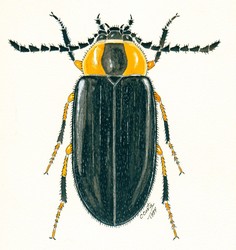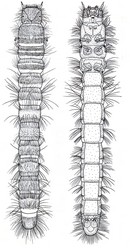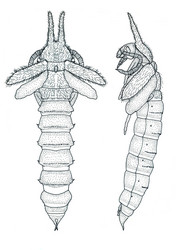Cneoglossidae
Cneoglossa
Cleide Costa and Sergio Antonio Vanin- Cneoglossa brasiliensis Wittmer 1948
- Cneoglossa brevis Champion 1897
- Cneoglossa collaris Guérin-Méneville 1849
- Cneoglossa edsoni Costa, Vanin & Ide 1999
- Cneoglossa elongata Pic 1916
- Cneoglossa gounellei Pic 1916
- Cneoglossa lampyroides Champion 1897
- Cneoglossa peruanus Pic 1916
- Cneoglossa rufifrons Pic 1916
- Cneoglossa rufifrons var. testaceicollis Pic 1916
Introduction
Cneoglossidae, monogeneric to Cneoglossa Guérin-Méneville, 1849, a Neotropical genus with nine known species distributed from Mexico to Brazil (Rio Grande do Sul), is represented by very small beetles (3-5 mm in length) with soft integument, dark elytra, and a bicolored pronotum concealing partially the head when seen from above (Costa et al., 1999, 2005).
Adults are usually attracted to lights at night. The only known larvae of Cneoglossa (C. edsoni) were collected in a small shallow stream, with moderate to fast running water and muddy or sandy bottoms, depending on the declivity of hill sides. The water was clear and slightly acidic (pH 6.0-6.2). The cneoglossid larvae were found inside submerged rooting brushwood, together with some larvae of Lutrochidae (Lutrochus germari Grouvelle, 1889) and Elmidae (Macrelmis sp.) (Costa et al., 1999).
Characteristics
Based on (Costa et al., 1999, 2005)
Adults
- Body elongate, lampyriform, weakly sclerotized.
- Head deeply retracted into prothorax. Transverse occipital ridge present. Median endocarina absent.
- Ommatidia exocone. Antennae 11-segmented, serrate. Fronto-clypeal suture absent. Mandibles symmetrical; very small; foliaceus; mola absent. Maxillae with palp 4-segmented, galea 1-segmented, lacinia reduced. Labium with mentum sub-trapezoidal; labial palpi 3-segmented; ligula broad, transverse.
- Pronotum with posterior margin lacking crenulations; postcoxal extension of hypomeron absent; coxal cavities broadly open externally and internally; trochantin exposed, freely moveable.
- Elytron with ten elytral striae; scutellary striole absent.
- Membranous wing folding dryopoid-type; radial cell elongate, strongly oblique, r4 crossvein weak; proximal r-m (r4) crossvein between rs and m absent; 1st cubito-anal cell present; 2nd cubito-anal cell absent; medial field containing four veins in the maingroup.
- Mesosternum: sternal process present; coxal cavities reduced, internally well separated, laterally closed by episternum and epimeron; coxae narrowly separated by intercoxal process.
- Metasternum with longitudinal suture present (discrimen); transverse suture absent; coxal plates very oblique.
- Legs increasing gradually in length from front to posterior pair; tarsal formula 5-5-5, tarsomeres simple and elongate without membranous lobes or setose pads beneath, claws bearing a strong tooth at base; empodium highly reduced.
- Abdomen with five visible ventrites; the first 3 of which connate but separate by distinct sutures; 1st ventrite deeply excavate for reception of metacoxae, without intercoxal process. Male 9th tergite entire; 9th and 10th tergites not fused. Female 8th sternite with spiculum ventrale, with 1-paired projection.
- Aedeagus of trilobed type.
- Female genitalia: coxites divided; stylus present. Ovipositor moderately sclerotyzed.
Larvae
- Elongate; subcylindrical.
- Head prognathous with ventral mouthparts retracted.
- Epicranial suture and coronal suture short; frontal suture V-shaped, attaining the antennal bases.
- A pair of large stemmata next to antenna.
- Antennae 3-segmented, cylindrical with sensory appendix elongate.
- Clypeus and labrum transverse.
- Mandibles symmetrical; apices tridentate; prostheca formed by two parallel fringes of hairs; mola absent.
- Maxillae completely separated from labium by large maxillary articulating area concealed by expanded mentum.
- Gula membranous, elongate. Ventral epicranial ridge present.
- Spiracles biforous.
- Legs short, robust, tarsungulus unisetose.
- 9th abdominal segment without urogomphi.
- 10th segment with paired pygopods bearing 10-12 hooks; osmoregulatory organs present.
Pupae
- Adecticous, exarate, without gin-traps.
Taxonomy
Guérin-Méneville (1843) included Cneoglossa within the Dascillidae, but this is a nomen nudum, since C. collaris (type-species of Cneoglossa) was formally described by him only in 1849. Champion (1897) sustained the systematic position and erected the tribe Cneoglossini. Crowson (1972) transferred it to the Cantharoidea, including it in his new family Cneoglossidae. Lawrence (1982) followed Crowson’s (l. c.) ideas, but latter (1988) he included it in his Psephenoidea (Psephenidae, Callirhipidae, Eulichadidae, Cneoglossidae, Ptilodactylidae and Chelonariidae). Lawrence & Britton (1991) transferred Cneoglossidae to Byrrhoidea plus Psephenoidea of Lawrence (1988).
Classification
(based on Costa et al., 1999)
- Coleoptera, Polyphaga, Elateriformia, Byrrhoidea
- Cneoglossidae Champion, 1897
- Cneoglossa Guérin-Méneville, 1849
- Cneoglossa Guérin-Méneville, 1849 (type species: Cneoglossa collaris Guérin-Méneville, 1849).
- Buckodrillus Wittmer, 1948 (type species: Buckodrillus brasiliensis Wittmer, 1948).
Relationships of Cneoglossidae to Other Beetles
Lawrence et al. (1995) presented a cladistic analysis of the Elateriformia plus Scirtoidea. The authors considered Psephenidae as the sister group of Cneoglossidae, including both in their expanded Byrrhoidea. Lawrence & Newton (1995) placed Cneoglossidae within Byrrhoidea, suggesting a position near Ptilodactylidae or Psephenidae. Beutel (1995), in a cladistic analysis of Elateriformia based only on morphological structures of immatures stages, emphasized the characters transformation of the head which according to him play a predominant role in the evolution, but did not present a new classification of that series.
Costa et al. (1999) in a cladistics analysis of Byrrhoidea pointed out a sister-group relationship between Cneoglossidae and Psephenidae supported by the presence, in adults, of paired glandular openings on abdominal tergites. The same sister-group relationship was evidenced by Lawrence et al. (1995).
Larvae of Cneoglossa (C. edsoni) are very similar to larvae of species of Anchytarsinae and Epilichinae (Ptylodactylidae). However, according to the cladistic analyses conducted by Costa et al. (1999), this resemblance (v.g. presence of paired pygopodium with apical hooks and osmoregulatory organs) is interpreted as the result of homoplasies shared by aquatic larvae of distinct and independent lineages, subject to convergent adaptations to life in fast running waters.
References
Beutel, R. G. 1995. Phylogenetic analysis of Elateriformia (Coleoptera: Polyphaga) based on larval characters. J. Zool. Syst. Evol. Res. 33(4):145-171.
Champion, G. C. 1897. Fam. Dascillidae, p. 586-662, pls. 26-27. In Biologia Centrali-Americana. Insecta, Coleoptera, Serricornia. London, Taylor & Francis, v. 3, pt. 1, xvi + 690 p., 27 tabs.
Costa, C.; S. A. Vanin & S. Ide. 1999. Systematics and bionomics of Cneoglossidae with cladistics analysis of Byrrhoidea sensu Lawrence & Newton (1995) (Coleoptera Elateriformia). Arquivos de Zoologia, São Paulo, 35 (3): 231-300.
Costa, C.; S. A. Vanin & S. Ide. 2005. 16.8. Cneoglossidae, p. 533-536, 8 figs. In: R. G. Beutel & R. A. B. Leschen (eds.). Handbook of Zoology / Handbuch der Zoology, Volume / Band IV Arthropoda: Insecta, Part / Teilband 38, Coleoptera: Evolution and Systematics (Archostemata, Myxophaga, Polyphaga part). Jena, Friedrich-Schiller-Universität Jena.
Crowson, R. A. 1972. A review of classification of Cantharoidea (Coleoptera), with the definition of two new families, Cneoglossidae and Omethidae. Revta Univ. Madr. 21(82):35-77.
Guérin-Méneville, F. É. 1843. Note sur un groupe naturel ou une petite tribu de coléoptères de la famille des Malacodermes. Revue zool. 6 (7):193-194.
Guérin-Méneville, F. É. 1849. Spécies et iconographie générique des animaux articulés ou représentation des genres avec leur description et celle de toutes les espèces de cette grande division du règne animal...I. Coléoptères. Paris, auteur, v. 9, p. 1.
Lawrence, J. F. 1982. Coleoptera, p. 482-553. In S. P. Parker (ed.). Synopsis and classification of living organisms. New York, McGraw-Hill, Inc., v. 2, 1232 p., pls. 88-141.
Lawrence, J. F. 1988. Rhinorhipidae, a new beetle family from Australia, with comments on the phylogeny of Elateriformia. Invert. taxon. 2(1987):1-53.
Lawrence, J. F. & E. B. Britton. 1991. Coleoptera (Beetles), ch. 35, p. 543-683. In CSIRO Division of Entomology (ed.). The insects of Australia. A textbook for students and research workers. Carlton, Melbourne University Press, 2nd edition, v. 2, i-vi + 543-1137 p.
Lawrence, J. F. & A. F. Newton, Jr. 1995. Families and subfamilies of Coleoptera (with selected genera, notes, references and data on family-group names), p. 779-1092. In J. Pakaluk & S. A. Slipinski (eds.). Biology, phylogeny, and classification of Coleoptera: papers celebrating the 80th birthday of Roy A. Crowson. Warszawa, Muzeum i Instytut Zoologii PAN, v. 2, i-vi + 559-1092 p.
Lawrence, J. F.; N. B. Nikitsky & A. G. Kirejtshuk. 1995. Phylogenetic position of Decliniidae (Coleoptera: Scirtoidea) and comments on the classification of Elateriformia (sensu lato), p. 375-410. In J. Pakaluk & S. A. Slipinski (eds.). Biology, phylogeny, and classification of Coleoptera: papers celebrating the 80th birthday of Roy A. Crowson. Warszawa, Muzeum i Instytut Zoologii PAN, v. 1, i-xii + 1-558 p.
Wittmer, W. 1948. 7. Beitrag zur Kenntnis der neotropischen Malacodermata. Revta Soc. ent. argent. 14(4):215-222.
Title Illustrations

| Scientific Name | Cneoglossa edsoni |
|---|---|
| Comments | paratype specimen |
| Specimen Condition | Dead Specimen |
| Identified By | Costa, Vanin & Ide |
| Sex | Male |
| Life Cycle Stage | adult |
| View | dorsal |
| Size | 4.5mm |
| Copyright |
© 2011 Cleide Costa

|
| Scientific Name | Cneoglossa edsoni |
|---|---|
| Specimen Condition | Dead Specimen |
| Identified By | Costa, Vanin & Ide |
| Life Cycle Stage | larva, final instar |
| View | dorsal and ventral |
| Size | 14.9 mm |
| Copyright |
© 2011 Cleide Costa

|
| Scientific Name | Cneoglossa edsoni |
|---|---|
| Specimen Condition | Dead Specimen |
| Identified By | Costa, Vanin & Ide |
| Life Cycle Stage | pupa |
| View | dorsal and lateral |
| Size | 12.6 mm |
| Copyright |
© 2011 Cleide Costa

|
About This Page
We thank Ricardo P. Vanin for the electronic treatment of figures of larvae and pupae. To Conselho Nacional de Desenvolvimento Científico e Tecnológico (CNPq) for the Research Grant 302721/2007 – 0 to C. Costa.
Cleide Costa

Museu de Zoologia, Universidade de São Paulo, Brasil

Departamento de Zoologia, Instituto de Biociências, Universidade de São Paulo
Correspondence regarding this page should be directed to Cleide Costa at and Sergio Antonio Vanin at
Page copyright © 2011 Cleide Costa and
 Page: Tree of Life
Cneoglossidae. Cneoglossa.
Authored by
Cleide Costa and Sergio Antonio Vanin.
The TEXT of this page is licensed under the
Creative Commons Attribution-NonCommercial License - Version 3.0. Note that images and other media
featured on this page are each governed by their own license, and they may or may not be available
for reuse. Click on an image or a media link to access the media data window, which provides the
relevant licensing information. For the general terms and conditions of ToL material reuse and
redistribution, please see the Tree of Life Copyright
Policies.
Page: Tree of Life
Cneoglossidae. Cneoglossa.
Authored by
Cleide Costa and Sergio Antonio Vanin.
The TEXT of this page is licensed under the
Creative Commons Attribution-NonCommercial License - Version 3.0. Note that images and other media
featured on this page are each governed by their own license, and they may or may not be available
for reuse. Click on an image or a media link to access the media data window, which provides the
relevant licensing information. For the general terms and conditions of ToL material reuse and
redistribution, please see the Tree of Life Copyright
Policies.
- First online 16 February 2011
- Content changed 16 February 2011
Citing this page:
Costa, Cleide and Sergio Antonio Vanin. 2011. Cneoglossidae. Cneoglossa. Version 16 February 2011 (under construction). http://tolweb.org/Cneoglossa/9127/2011.02.16 in The Tree of Life Web Project, http://tolweb.org/












 Go to quick links
Go to quick search
Go to navigation for this section of the ToL site
Go to detailed links for the ToL site
Go to quick links
Go to quick search
Go to navigation for this section of the ToL site
Go to detailed links for the ToL site